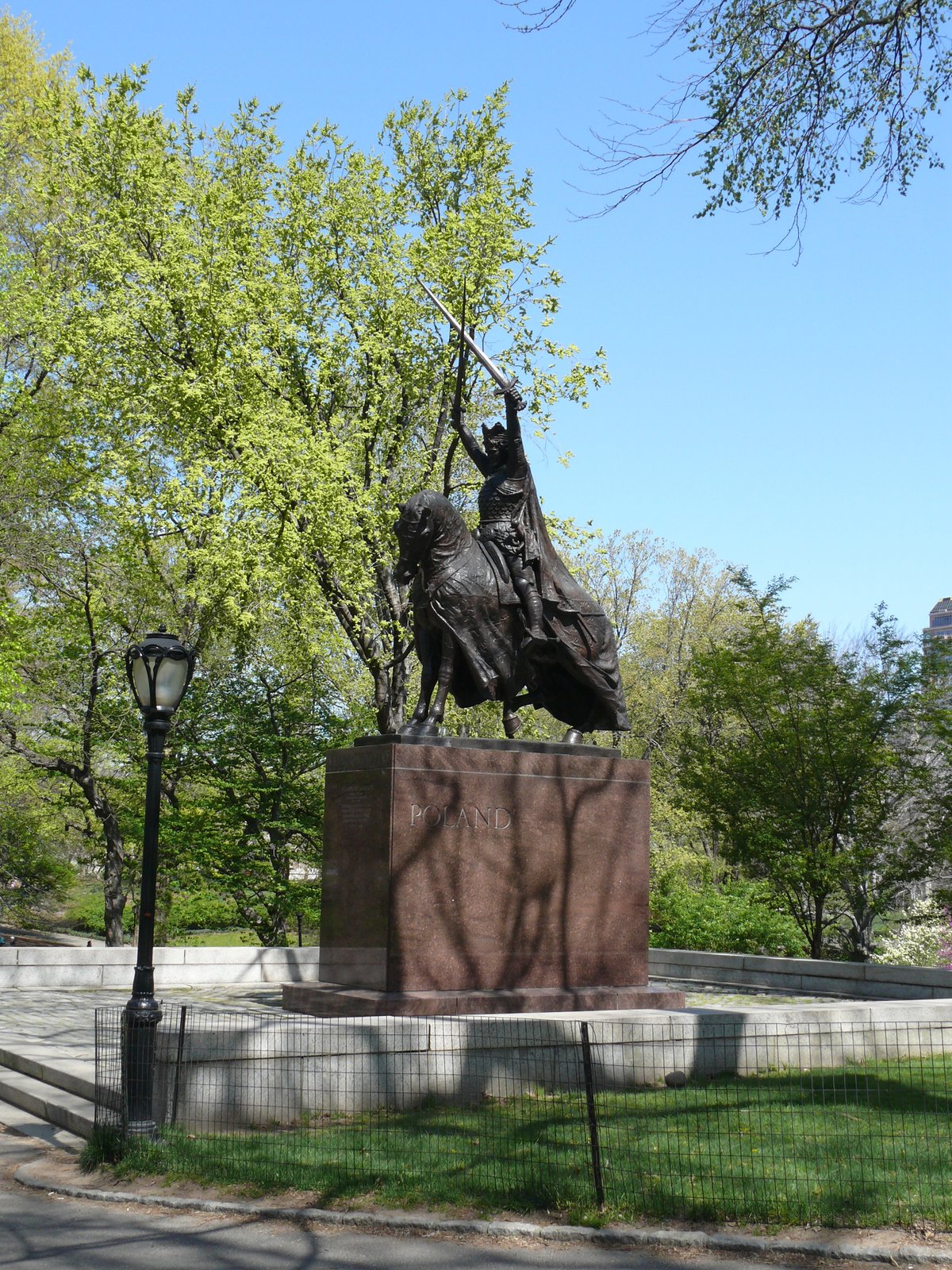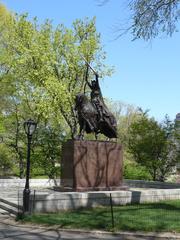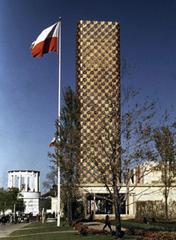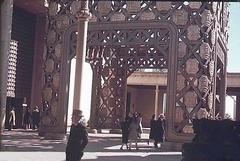
King Jagiello Monument New York City: Visiting Hours, Tickets, and Historical Significance
Date: 15/06/2025
Introduction
The King Jagiello Monument, a towering bronze equestrian statue, stands as a prominent landmark in Central Park, New York City. Commemorating King Władysław II Jagiełło—a pivotal figure in Polish and Lithuanian history—it not only represents a defining medieval victory at the Battle of Grunwald but also serves as a powerful symbol of Polish heritage, unity, and resilience in the United States. Originally crafted by Polish sculptor Stanisław K. Ostrowski for the 1939 New York World’s Fair, the monument’s story is deeply entwined with the upheavals of World War II, ultimately finding its permanent home in Central Park in 1945 (Central Park Conservancy; NYC Parks; Polish Cultural Institute NY).
This guide provides a comprehensive overview for visitors, detailing the monument’s origins, artistic and cultural significance, location, visiting hours, transportation, nearby attractions, and tips for making the most of your visit.
Table of Contents
- Historical Background and Cultural Significance
- Artistic Features and Symbolism
- Installation and Legacy in Central Park
- Visiting Information: Hours, Tickets, and Accessibility
- How to Get There & Transportation
- Nearby Attractions and Suggested Walking Routes
- Events, Commemorations, and Community Engagement
- Visitor Tips and Etiquette
- Frequently Asked Questions (FAQ)
- Conservation and Preservation
- Summary and Encouragement to Explore Further
- References and Further Reading
Historical Background and Cultural Significance
The King Jagiello Monument honors Władysław II Jagiełło (c. 1352–1434), Grand Duke of Lithuania and King of Poland, whose leadership at the Battle of Grunwald in 1410 shaped Eastern European history. The victory over the Teutonic Knights became a lasting symbol of Polish-Lithuanian unity and resistance.
Created for the Polish Pavilion at the 1939 New York World’s Fair, the statue was meant to celebrate Poland’s medieval heritage. The outbreak of World War II, however, rendered a return to Poland impossible, and the statue remained in New York. As such, it evolved into a poignant emblem of the Polish diaspora and the enduring fight for national sovereignty (Central Park Conservancy; Polish Cultural Institute NY).
After the war, the Polish government-in-exile and Polish-American community gifted the statue to the City of New York, and it was officially installed in Central Park in 1945, becoming a site of both remembrance and celebration for generations.
Artistic Features and Symbolism
Stanisław K. Ostrowski’s sculpture is a masterful blend of dynamic movement and historical detail. The bronze statue, standing 14 feet high and weighing approximately 8,000 pounds, depicts King Jagiełło in full armor atop a spirited horse, brandishing two crossed swords. This imagery references the famed moment before the Battle of Grunwald when the Teutonic Knights presented Jagiełło with two swords as a provocation—an event the king transformed into a call for unity and defiance.
The statue’s granite pedestal, inscribed in both English and Polish, features heraldic emblems of Poland and Lithuania. The horse is shown in motion, with meticulously detailed veins and a caparison, while the king’s mantle displays the Polish eagle and Lithuanian knight (Public Art Around the World; Wikipedia).
Ostrowski’s artistic choices emphasize strength, resilience, and the dramatic tension of history, making the monument a compelling piece of public art.
Installation and Legacy in Central Park
After the closure of the 1939 World’s Fair, the statue was unable to return to an occupied and war-torn Poland. In 1945, the City of New York accepted the monument as a gift, and it was installed at the east end of Turtle Pond, near the Great Lawn in Central Park. The unveiling coincided with the anniversary of the Battle of Grunwald, reinforcing the monument’s symbolic power.
The monument has since become a focal point for Polish-American heritage events and commemorations, reflecting the ongoing contributions of the Polish community to New York’s cultural landscape (NYC Parks).
Visiting Information: Hours, Tickets, and Accessibility
- Location: East side of Turtle Pond, near the intersection of East Drive and 79th Street Transverse, Central Park, NYC (Central Park NYC).
- Visiting Hours: Central Park is open daily from 6:00 AM to 1:00 AM. The monument is accessible during these hours.
- Tickets/Admission: No ticket or entrance fee is required—the monument is free and open to the public.
- Accessibility: Paths to the monument are paved and wheelchair accessible. Nearby restrooms are available at Belvedere Castle and the Delacorte Theater.
How to Get There & Transportation
Subway:
- 81st Street–Museum of Natural History (B, C lines): ~10-minute walk across the park.
- 77th Street (6 line): ~15-minute walk.
- 59th Street–Columbus Circle (A, B, C, D, 1 lines): About a 15-minute walk north.
Bus:
- M79 crosstown (stops at 79th Street).
- Multiple routes along Central Park West and Fifth Avenue.
Parking:
Street parking is limited and metered. Use of public transportation is highly recommended (The Tourist Checklist).
Entrances:
Enter Central Park via 79th Street from either the east (Fifth Avenue) or west (Central Park West), then follow signage to Turtle Pond and Belvedere Castle.
Nearby Attractions and Suggested Walking Routes
- Belvedere Castle: A historic visitor center and observation deck, offering panoramic park views.
- Turtle Pond: A tranquil spot for birdwatching and relaxation.
- Shakespeare Garden: A four-acre landscaped garden with plants referenced in Shakespeare’s works.
- The Ramble: A woodland maze of trails, ideal for nature lovers.
- Great Lawn: Popular for picnics, sports, and concerts.
- Metropolitan Museum of Art: A short walk to the northeast.
Incorporate the King Jagiello Monument into self-guided or themed walking tours of Central Park’s midsection for a rich blend of art, history, and natural beauty (Central Park NYC; Trek Zone).
Events, Commemorations, and Community Engagement
The monument is the site of annual events celebrating Polish heritage, most notably on Polish Constitution Day (May 3) and the anniversary of the Battle of Grunwald (July 15). These occasions often feature wreath-laying ceremonies, concerts, and cultural programs that highlight the enduring bonds between Poland and the United States (Polish Cultural Institute NY).
Visitor Tips and Etiquette
- Photography: Non-commercial photography is welcome. Early mornings and late afternoons offer the best light.
- Picnicking: Turtle Pond and the Great Lawn are ideal for picnics. Please follow park rules and dispose of litter properly.
- Respect: Climbing on the monument is strictly prohibited.
- Quiet Reflection: The monument is often used for remembrance and contemplation—please be considerate of others.
- Safety: Central Park is generally safe during daylight hours; remain aware of surroundings after dark.
Frequently Asked Questions (FAQ)
Q: What are the King Jagiello Monument visiting hours?
A: The monument is accessible during Central Park hours, 6:00 AM–1:00 AM daily.
Q: Is there an entrance fee or ticket required?
A: No, it is free and open to the public.
Q: Is the monument wheelchair accessible?
A: Yes, paved paths and accessible routes are available.
Q: Are guided tours available?
A: Yes, several Central Park tours include the monument. Check with the Central Park Conservancy or local operators for details.
Q: Can I attend cultural events at the monument?
A: Yes, particularly during Polish heritage commemorations and special anniversaries.
Conservation and Preservation
The King Jagiello Monument has benefited from multiple conservation efforts, ensuring its longevity as a major public artwork. The Central Park Conservancy and the NYC Department of Parks & Recreation oversee regular maintenance and restoration, including significant work in 1986 and 2016 to preserve the statue’s patina and structure (Wikipedia; Central Park Conservancy).
Summary and Encouragement to Explore Further
The King Jagiello Monument stands as a testament to courage, unity, and the rich tapestry of immigrant heritage in New York City. Its stunning artistry and historical resonance make it a must-visit destination for anyone exploring Central Park or interested in the intersections of art, history, and culture. Accessible free of charge and surrounded by some of the park’s most beautiful scenery, the monument invites reflection and discovery year-round.
To enhance your visit, consider joining a guided tour, attending a commemorative event, or exploring nearby attractions. For up-to-date guides and audio tours, download the Audiala app and follow us on social media for cultural updates and insights.
References and Further Reading
- Central Park Conservancy: King Jagiello Monument
- NYC Parks: King Jagiello Monument
- Polish Cultural Institute NY: King Jagiello Monument
- Central Park Story: King Jagiello & Belvedere Castle
- NYC Parks: King Jagiello Monument (additional entry)
- The Tourist Checklist: Belvedere Castle & King Jagiello
- Wikipedia: King Jagiello Monument
- Public Art Around the World: King Jagiello Monument
- Trek Zone: King Jagiello Monument
- Daytonian in Manhattan: King Jagiello Statue

























































































































































































































































































